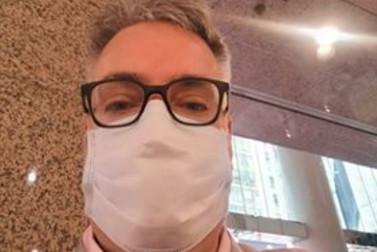“Hong Kong is definitely coming back to life” following a weeks-long coronavirus lockdown, says Adam Najberg, an American executive who’s been living in the territory for over a decade. “It’s clearly not bustling, and restaurants aren’t brimming with activity, but people are going out again, shopping again, walking on the streets.”
“You have to wait a bit for taxis, people are back on the subway and buses. Traffic is back, [the] subway is getting more crowded again, [and there’s] more foot traffic, too.”
Najberg spoke with MarketWatch via Facebook Messenger to describe his recent experiences in Hong Kong, and how the Chinese territory has dealt with the coronavirus outbreak.
“It was tense six weeks ago,” he said. “Uncertainty about how bad it might be was hanging over folks, especially those remembering SARS. Now, honestly, my two biggest personal concerns are about my kids in the U.S. and whether there is Diet Coke in the vending machine. The U.S. doesn’t get this, and the years of polarization and complacency and comfort lull people into not taking this seriously enough.”
Hong Kong is getting through this because the territory went to an emergency lockdown to stem the growing COVID-10 outbreak for three weeks in January and February, Najberg said. While the coronavirus has not been eradicated in Hong Kong, the territory has managed to severely slow the spread of the illness. According to the Johns Hopkins coronavirus tracker, Hong Kong has had a total of 155 confirmed cases, out of a population of 7.4 million.
Najberg said had to work from home for a few weeks. “Everyone masked up, work from home was implemented, [and] many companies have alternating shifts of staffers at the office, even though we’re back now,” he said. The territory did an enormous number of tests and quarantined the sick.
 Adam Najberg
Adam Najberg “Many companies followed the government’s lead — [civil] servants, except for critical and health services, worked from home. Buildings and compounds — and individual companies — put [their] own containment and safety measures in place, too. My gym in my compound shut temporarily. The club restaurant delivers, but they stopped dine-in service. I joined another gym temporarily, paying their fee. They have temperature checks in place and scrub every surface religiously after equipment use.”
“Its peak looks to have passed here. They’ve done a pretty solid job containing it. When you read the stories, it’s a bit crazy how they cherchez le virus.”
To be sure, Hong Kong is not out of the woods yet, and officials there worry about complacency and a potential second wave of cases, according to a Bloomberg News report.
Meanwhile, much of the rest of the world is in chaos or bracing for impact.
So what is the new normal on the other side of the lockdown?
“We came back to the office in shifts, not everyone at once,” Najberg said. “We all fill out daily health-check surveys online. They take about 15-30 seconds. And did it work? It worked to help ensure social-distancing. When we returned, we entered only through the doors on one floor, had our temperatures checked, stepped on a disinfection carpet outside the door and then put on a mask to go to our desks. I keep my mask on when I’m walking the floor and when I’m in public spaces. The building took over temperature checks, using a FLIR scanner at the entrance to the office towers. You don’t have to stop. You just walk past the scanner and it checks temperatures. And entrances on multiple floors have reopened. We still mask up inside the office and in public spaces.
“So, did it work? So far, seems to be fine. We also adhere to Hong Kong’s travel and self-quarantine policies and have our own company policies to keep those who might have been exposed and others around them safe, which means if you’ve had contact with someone or traveled somewhere where there is a virus risk, you do work-from-home until you’re allowed back and it’s clear you’re not ill.”
“You get a temple-checked thermometer reading at many places…. Hand sanitizer everywhere. Elevator buttons disinfected once an hour, offices deep disinfected once a week, etc. My building still takes my temperature every time I come back from Starbucks. Elevator buttons are covered with plastic that is disinfected every hour.”
In the new normal, most people wear masks when they’re out, Najberg said. If you go to a restaurant, you take them off only when you get inside. There is debate about how useful masks are in helping protect against the disease. Najberg said they work for another reason.
“The masks are more a sign to keep your distance. And it works. Plus, you touch your face less when wearing a mask.
“I’m told this is what SARS was like. They were not ready for SARS. My observation in returning to [Hong Kong] 10 years ago was that it was much cleaner than before. SARS led to hygiene and a major upgrade in pandemic preparedness. This is THE place to be when you have a health crisis. They are ready for quarantine. They already have several quarantine camps.
“The thing I’d say about Hong Kong, after living here nearly 10 years this time — and 15 in total — is that people here follow social ‘protocol’ and are respectful of measures to contain illness. Yes, there was some panic-buying of toilet paper, rice and noodles and some oils, but overall, it has been very orderly. People take this extremely seriously from government on down, and they listen and care about the health and safety of others, not just themselves.”
div > iframe { width: 100% !important; min-width: 300px; max-width: 800px; } ]]>








